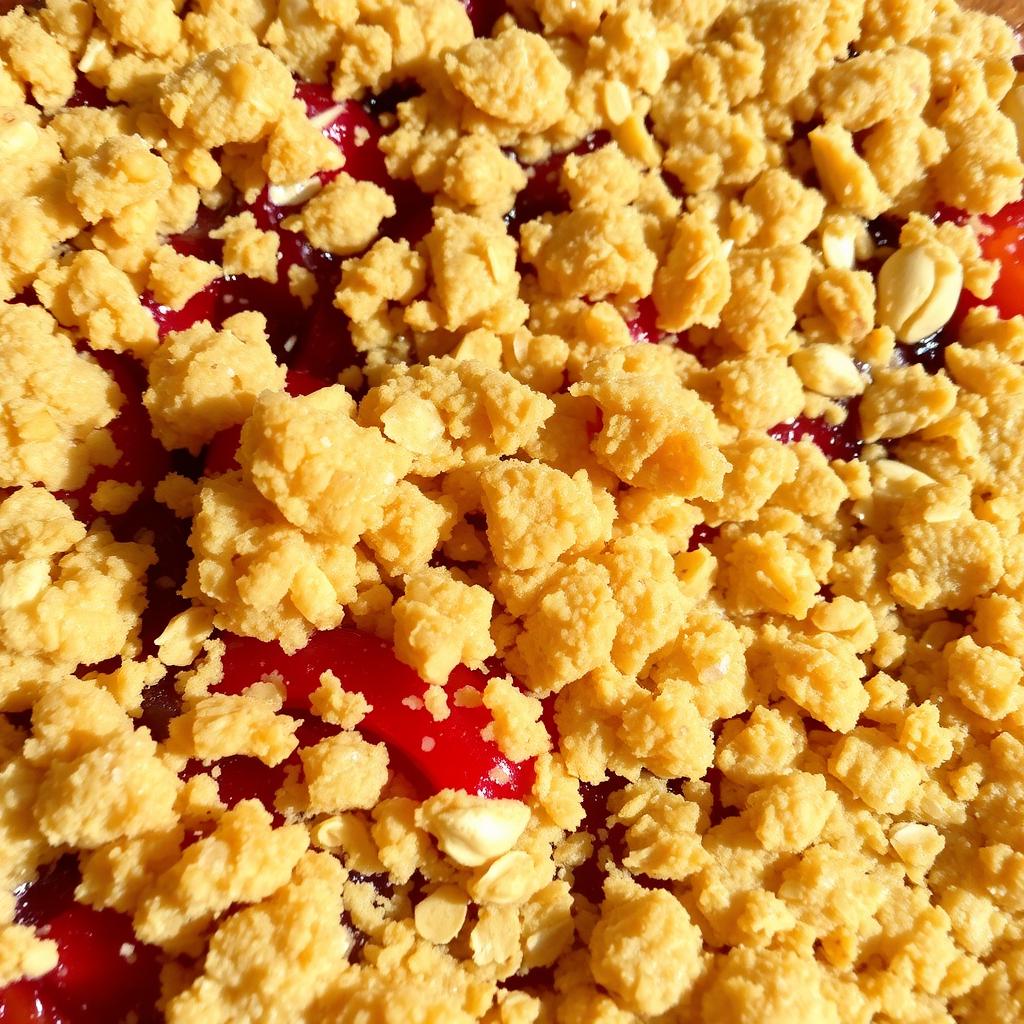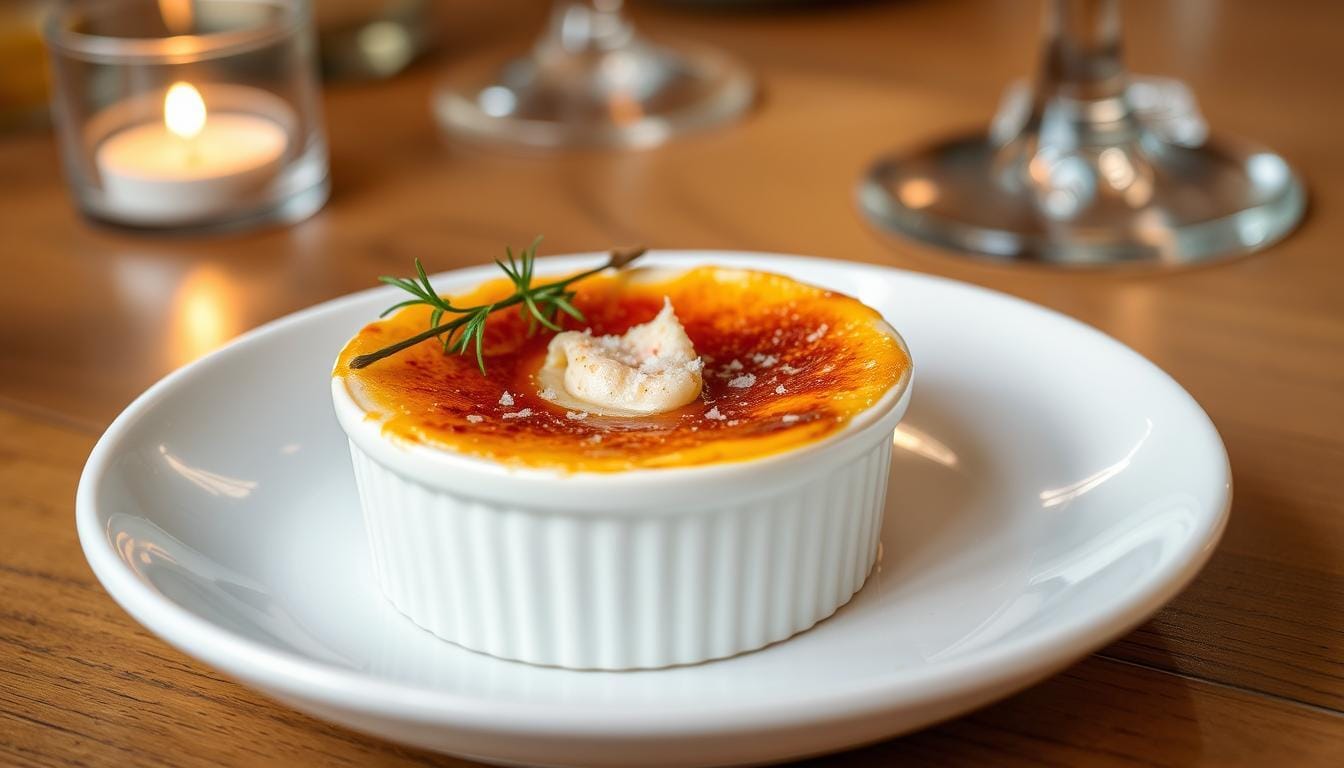The humble crumble is a favorite dessert topping. It can turn any baked treat into something amazing. But getting that crunchy texture can be hard. Don’t worry, we’ve got the secrets to make your crumble crunchy with every bite.
In this guide, we’ll explore the science of perfect crumble texture. We’ll look at the key ingredients, mixing techniques, and baking methods. Whether you’re experienced or new to crumbles, you’ll learn how to make your desserts crunchy and delicious.
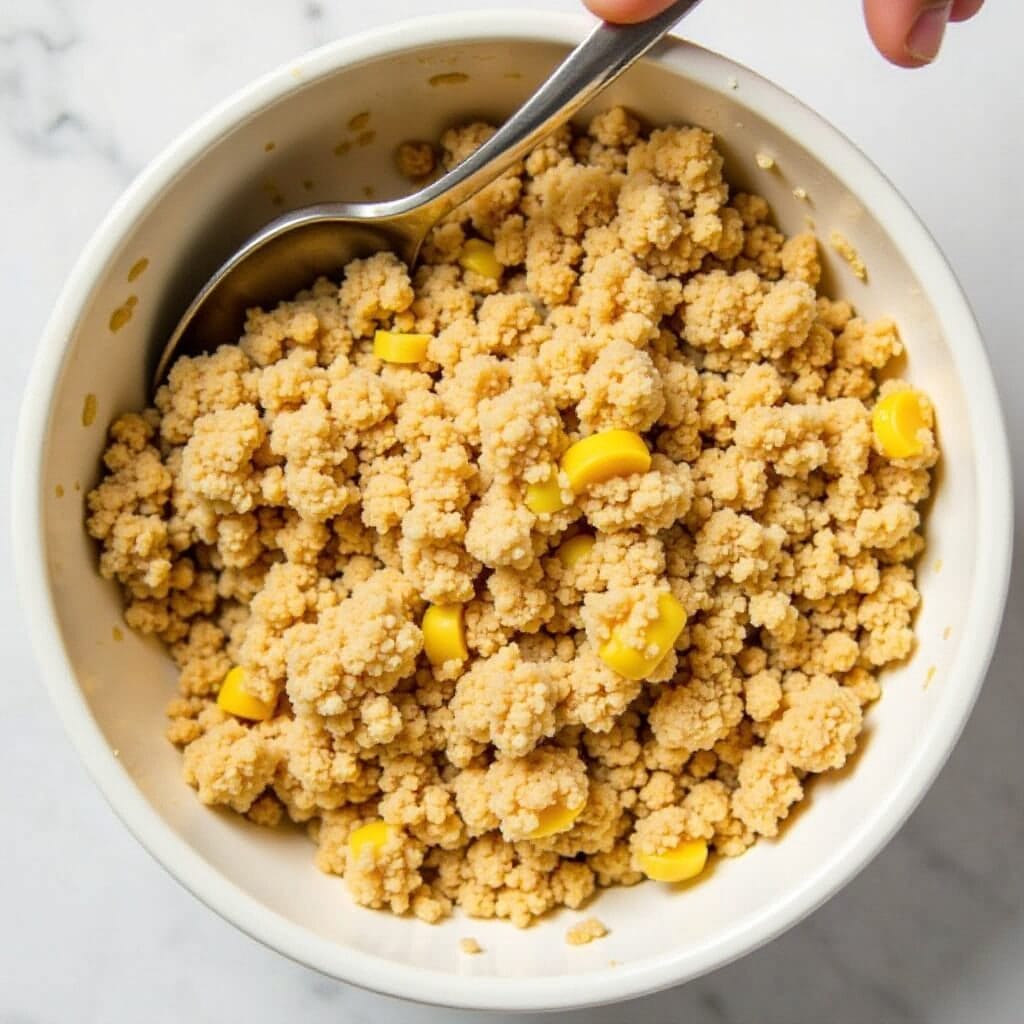
Key Takeaways
- Understand the importance of butter temperature and the right sugar-to-flour ratio for achieving the perfect crumble texture.
- Discover the chemical reactions that occur during baking and how they impact the final crunchiness of your crumble.
- Learn the essential ingredients and their roles in creating a crispy crumble topping.
- Explore proper mixing techniques and temperature control tips to ensure your crumble reaches maximum crunchiness.
- Identify and fix common mistakes that lead to a soggy crumble, such as overbaking or using the wrong baking equipment.
Understanding the Science Behind Perfect Crumble Texture
Getting the perfect crunch in your crumble topping is more than just following a recipe. It’s about understanding crumble science, baking chemistry, and the right mix of ingredients. Let’s explore what makes a crumble texture truly perfect.
The Role of Butter Temperature
Butter is key in any crumble topping, and its temperature is crucial. Cold butter makes the topping crunchy, while warm butter makes it dense. The best approach is to use butter that’s just a bit chilled. This way, it mixes well with other ingredients without being too greasy.
Sugar and Flour Ratios
The right mix of sugar and flour is essential. Too much sugar makes the topping sweet and sticky. Too much flour makes it dry and tough. Finding the ideal ingredient ratios creates a crumble that’s crunchy and sweet.
Chemical Reactions During Baking
When your crumble bakes, chemical reactions change its texture and taste. The heat melts the butter and caramelizes the sugars. The flour gelatinizes, leading to a crunchy, golden-brown topping. Knowing these baking chemistry principles helps you perfect your crumble texture.
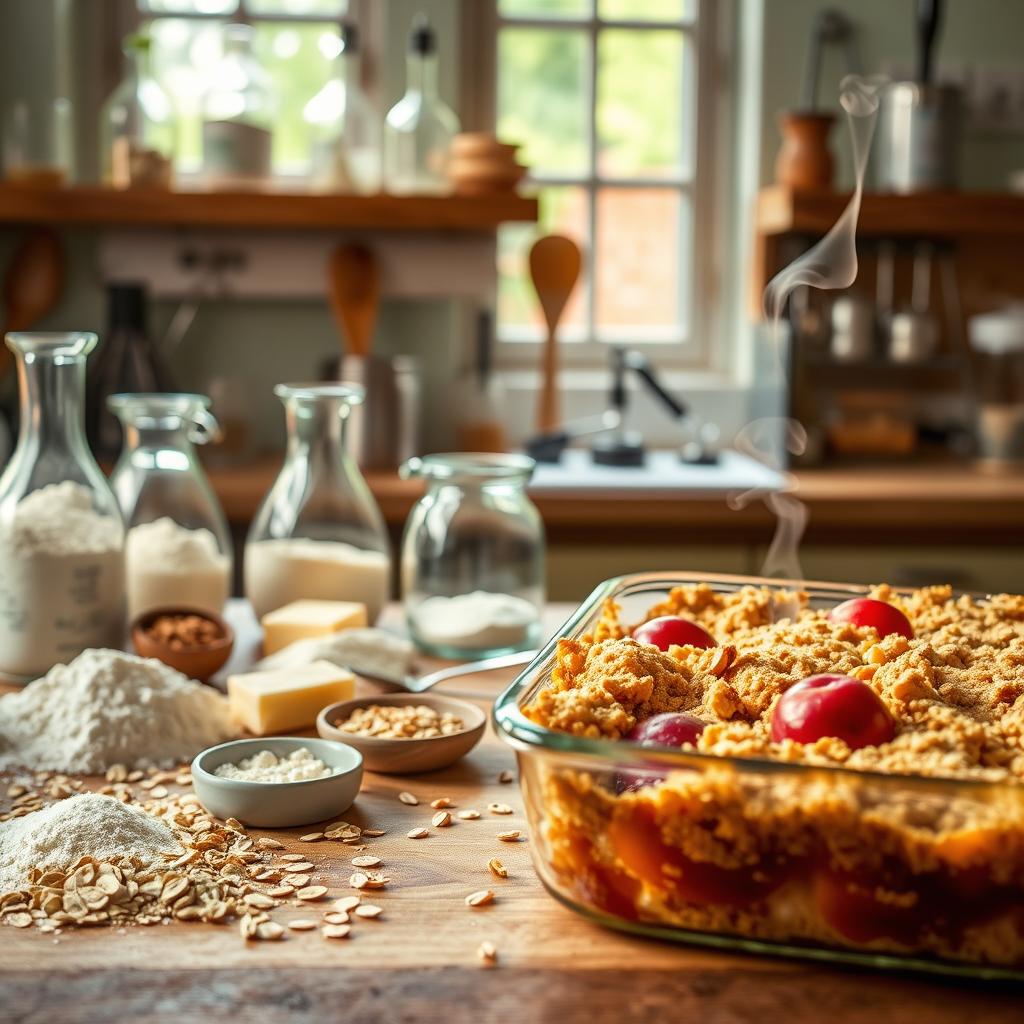
“The secret to a perfect crumble is in mastering the intricate dance of temperature, ingredient ratios, and chemical reactions.”
Exploring the science behind crumble texture opens up the secrets to a crunchy topping. This will take your baked goods to new heights.
Essential Ingredients for a Crunchy Crumble Topping
To make a perfect crunchy crumble topping, you need the right ingredients. Whether you’re making a peach crumble or trying other fruits, knowing the crumble ingredients is key. This ensures your topping is crunchy.
The base of a great crumble is the best flour for crumble. Use all-purpose flour or a mix of all-purpose and whole wheat flour. This gives it structure. For a crunchier topping, add oats. They add a nutty flavor and a nice crunch.
- All-purpose flour: The backbone of the crumble topping
- Whole wheat flour: Adds heartiness and fiber
- Rolled oats: Enhances texture and flavor
The right fat is also important for a crunchy topping. Chilled, cubed butter is a classic choice. It makes the topping buttery and delicious. For a dairy-free option, use cold coconut oil or vegan butter.
A bit of sugar is needed to balance the richness. Brown sugar or a mix of brown and granulated sugar is great. It caramelizes and crisps up in the oven.
| Ingredient | Purpose |
|---|---|
| All-purpose flour | Provides structure and body |
| Butter or coconut oil | Adds richness and crunch |
| Brown sugar | Enhances flavor and caramelization |
With these crumble ingredients, you’re ready to make a crunchy and delicious crumble topping. Your family and friends will love it.
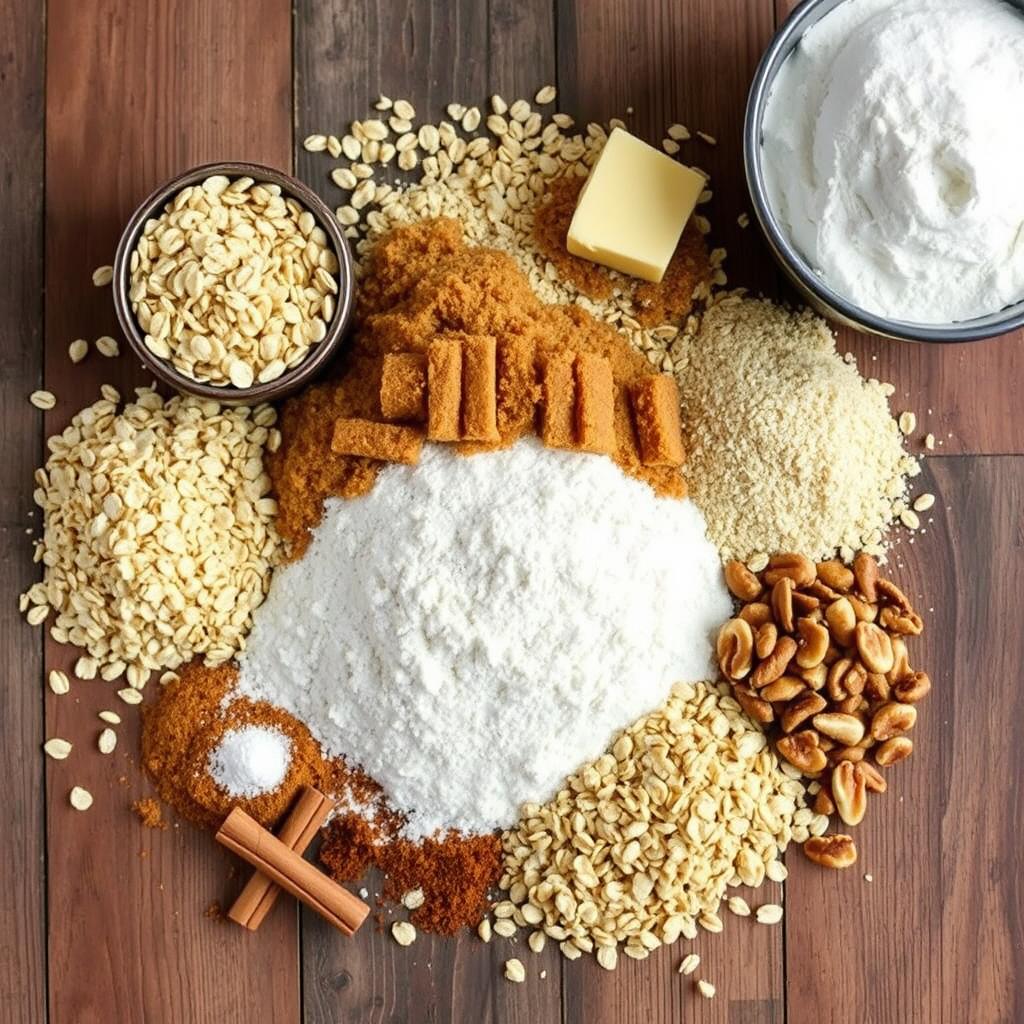
“The secret to a truly crunchy crumble lies in the perfect balance of flour, fat, and sugar.”
How do I Get My Crumble Crunchy?
Getting your crumble topping crunchy is all about the right techniques. It’s about mixing, temperature, and timing. Let’s explore how to make your crumble topping crispy and delicious.
Proper Mixing Techniques
Mixing your crumble ingredients the right way is key. Don’t overdo it, as it can make the topping dense. Instead, mix the butter, flour, and sugar gently until it looks like coarse breadcrumbs. This helps create a light and flaky texture.
Temperature Control Tips
Temperature is crucial for a crunchy topping. Make sure your oven is at the right temperature before baking. Keep an eye on it while it’s baking to avoid uneven cooking.
Timing Your Bake
- Watch your crumble closely while it bakes. Adjust the time if needed.
- Look for a golden-brown color and a crunchy texture.
- Let it cool completely before serving. It helps set the texture and prevents it from getting soggy.
Mastering these techniques will help you make a crunchy and tasty crumble topping. Try different ingredients and methods to find what works best for you.
Common Mistakes That Lead to Soggy Crumble
Getting the perfect crunch in your crumble topping is tricky. A few common mistakes can make it soggy. As you bake, watch out for these issues that can ruin your crumble’s crispiness.
One big problem is overmixing the ingredients. This can make the dough too dense and heavy. It should be light and airy instead.
- Avoid over-mixing the crumble mixture; gently fold the ingredients together until just combined.
- Be mindful of the butter temperature – using melted butter can result in a greasy, heavy crumble, while cold butter may not incorporate properly.
- Ensure the flour-to-sugar ratio is balanced; too much sugar can lead to a soggy crumble topping.
Another mistake is not baking the dish long enough. If it’s underbaked, the topping will be wet and doughy. So, keep an eye on the oven and follow the recipe’s timing.
“The key to a perfectly crunchy crumble is striking the right balance between the butter, sugar, and flour – not too much of any one ingredient.”
By avoiding these common mistakes, you can make sure your desserts have a crunchy, golden crumble every time.
Best Baking Equipment for Crispy Crumble Results
To get the perfect crumbly texture, start with the right baking equipment. The pan material and preparation tools are key. They help your crumble topping be crunchy every time.
Pan Selection Guide
The pan you choose affects your crumble’s texture and doneness. Think about these when picking the best pan:
- Material: Choose pans made of aluminum, stainless steel, or ceramic. They distribute heat well and prevent soggy bottoms.
- Size and shape: Pick a pan that fits your recipe. Square or round pans are best for crumble-topped desserts.
- Nonstick coating: A good nonstick surface makes the crumble easy to remove without sticking.
Must-Have Tools
Along with the right pan, some tools are essential for a perfect crumble topping:
- A sturdy mixing bowl for combining the crumble ingredients.
- A pastry cutter or two forks to mix the butter and dry ingredients.
- A rubber spatula for gently spreading the crumble over the filling.
Temperature Monitoring Devices
Controlling temperature is key for a crunchy crumble. Get a reliable oven thermometer and a food thermometer. They help you keep the baking temperatures just right.
“The key to a crunchy crumble is striking the perfect balance between butter, sugar, and flour. Proper temperature monitoring helps you nail that ratio every time.”
With the right equipment and attention to temperature, you’ll master the perfect crumbly topping. Remember these tips, and your crumble will be the star of every event.
Storage Solutions to Maintain Crunchiness
Keeping your homemade crumble crunchy is key for the perfect sweet and crispy taste. Whether it’s a fruit-filled crumble or a savory topping, the right storage keeps it crispy and textured for longer.
First, let your crumble cool down completely before storing. This step is vital to stop the crumble from getting soggy from steam. Once it’s cool, put it in an airtight container or a resealable bag. This ensures crumble storage that keeps the crunchiness locked in.
- For the best crumble storage, pick containers with tight lids or heavy-duty ziplock bags. They help keep the texture and crispiness intact.
- Stay away from storing crumble in containers with too much air. This can cause moisture and lose the texture.
- Try to store the crumble at room temperature in a cool, dry spot. Avoid places with changing temperatures and humidity, as they can ruin the crispiness.
To keep the crumble crispy when you’re ready to eat it, just reheat it in a preheated oven for a few minutes. This brings back the crunchy texture without losing the flavor or look of your tasty dish.
“Proper storage is the key to savoring the crunchiness of your homemade crumble long after baking.”
By using these easy storage tips, your crumble will stay crispy and textured every time. This lets you enjoy the perfect mix of flavors and textures in every bite.
Troubleshooting Your Crumble Texture Problems
Getting the perfect crumble topping can be tricky. Sometimes, it ends up soggy or too dry. But don’t worry, there are ways to fix it. You can salvage your soft topping and find the right texture.
Fixing Moisture Issues
Too much butter or not enough baking time can make your crumble soggy. Try using less butter or baking it longer. Sprinkling flour or cornstarch on top can also help soak up extra moisture.
Adjusting Ingredient Proportions
- Adding more flour or oats can make your topping drier and more structured.
- Less sugar can prevent the crumble from getting too sticky.
- Using coconut oil or shortening can make it crisper.
Recovery Methods for Soft Crumble
If your crumble is soft after baking, don’t give up. Spread it on a baking sheet and bake it again for a few minutes. You can also mix in oats or nuts to absorb moisture and add texture.
Every oven and recipe is unique. It might take some trial and error to get the perfect crumble. But with a bit of experimentation and these tips, you’ll get the crunch you want.
Expert Tips for Professional-Level Crunch
Many home bakers aim for a gourmet crumble topping with a professional crunch. With the right professional baking tips and expert advice, you can achieve this. Here are some insider secrets to master the perfect crunch.
Start by adding unique ingredients like chopped nuts or brown butter. These gourmet crumble elements can make your dessert stand out. Also, adjusting the flour to sugar ratio can greatly affect the outcome. So, don’t hesitate to experiment until you get it right.
- Chilling your dough before baking is crucial. It makes the butter firm, leading to a crunchier topping.
- Use a high-quality baking sheet or tart pan for even heat. This ensures your crumble bakes perfectly.
- Keep a close eye on your baking time and temperature. A bit of over-baking can make it crisp, but avoid burning.
By following these professional baking tips and expert advice, you’ll create crumble toppings that wow everyone. The secret to that coveted crunch is in the details and being open to trying new things.
| Ingredient | Proportion | Impact on Crunch |
|---|---|---|
| Butter | Chilled or Browned | Helps create a crisp, flaky texture |
| Sugar | Adjustable Ratio | Affects caramelization and crispness |
| Flour | Adjustable Ratio | Determines the overall structure and crunch |
| Nuts (Optional) | Chopped or Whole | Adds texture and nutty flavor |
Discover the secrets to a professional-level crunch and wow your guests with your gourmet crumble creations.
“The perfect crumble is a balance of crisp, buttery, and slightly sweet – a true delight for the senses.”
Conclusion
Creating the perfect crunchy crumble topping is a mix of science, skill, and trying new things. You now know how to make sure your crumble topping turns out great. This is thanks to understanding butter temperature, sugar and flour mix, and how baking works.
Start with the best ingredients and mix them right. Control the temperature and bake at the right time. Don’t make the common mistakes of overmixing or baking too short.
With these tips, you’re ready to make perfect crumble, crunchy topping success, and dessert mastery. Now, go ahead and show off your skills. Make your friends and family amazed with your perfect crumble dishes.
FAQ
What is the role of butter temperature in achieving a crunchy crumble texture?
The butter’s temperature is key for a crunchy crumble. Use cold, firm butter, cut into cubes or grated. This way, as it melts, it creates steam pockets, making the crumble flaky and crispy.
How do the ratios of sugar and flour affect the crunchiness of a crumble?
The sugar and flour ratio in the topping recipe is crucial. More sugar means a crunchier, caramelized topping. More flour makes it tender and breadcrumb-like.
What are the key chemical reactions that occur during baking that contribute to a crunchy crumble?
Baking triggers several reactions that make the crumble crunchy. Sugar caramelizes, and the Maillard reaction happens between amino acids and sugars. Moisture evaporation also plays a part, creating the crispy texture.
What are the best types of flour to use for a crunchy crumble topping?
Choose flours with high protein content for crunchiness. All-purpose or pastry flour works best. They form gluten, making the topping crisp and structured.
How do I ensure proper mixing techniques for a crunchy crumble?
Mixing right is key for a crunchy crumble. Don’t overwork the mix to avoid a tough texture. Mix gently, aiming for a coarse, pea-sized crumble.
What are the most common mistakes that can lead to a soggy crumble topping?
Common mistakes include using too much butter and not baking at high enough temperatures. Overbaking and not chilling the butter properly also lead to a soggy crumble.
What baking equipment is best for achieving a crispy crumble result?
Use a shallow baking dish for even heat and caramelization. The right tools, like a food processor or pastry cutter, make preparation easier and more effective.
How do I store a crumble topping to maintain its crunchiness?
Cool the baked dessert completely before storing. Store in an airtight container at room temperature. Avoid refrigeration to keep the topping crisp.
How can I salvage a soft or soggy crumble topping?
For a soft or soggy crumble, try baking it alone at a higher temperature to dry it out. Mixing in dry ingredients like flour or breadcrumbs can also help restore crunchiness.
